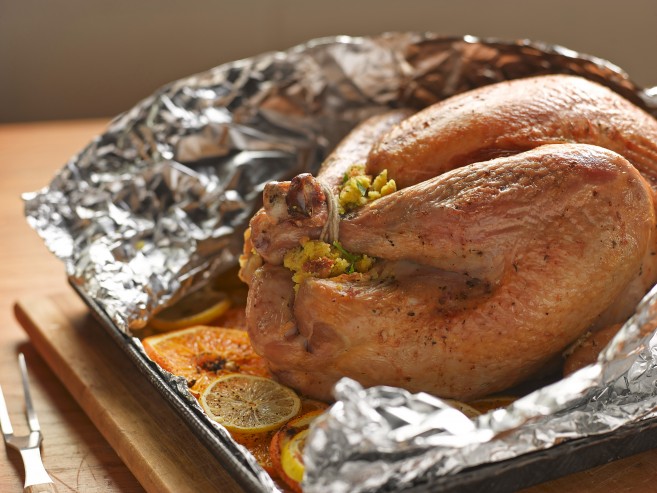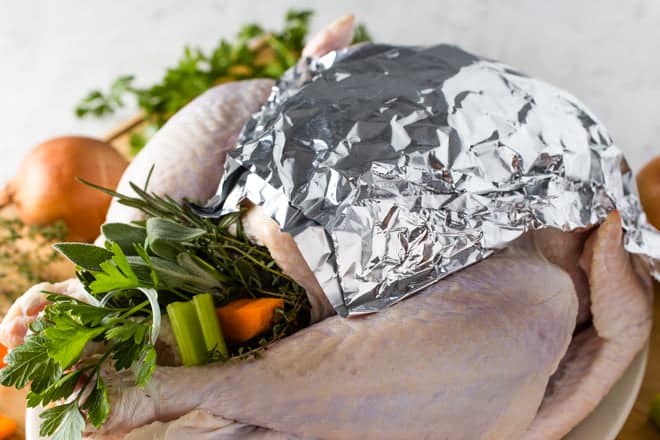A miraculous technique for roasting turkey using aluminum foil smeared with butter to protect the breast from intense heat, while basting it. The foil is removed at the end so that the skin can crisp up. This article also has information about brining, and whether you should do it, as well as tons of tips for perfectly roasted turkey.
You probably know that my parents owned and operated restaurants when I was growing up. What you might not know is that they also did a lot of catering. We estimate that they’ve catered over a thousand turkey dinners, with each dinner requiring numerous turkeys. Their dinners have always had rave reviews, and now, I’m explaining to you my mom’s technique for perfect roasted turkey. First we’ll talk about the size of the turkey that you need, then we’ll get into the cooking technique (it involves basting and crisping the skin with butter!) that gets you perfectly cooked, juicy meat – even the breast meat is juicy!
As a general rule, 1 and 1/2 pounds of bone-in turkey will feed one person and provide leftovers. If you are not a leftover family, 1 pound of bone-in turkey will be your mathematical formula. If you will be having a lot of side dishes, you can go with even less, around 3/4 of a pound. This is especially true if you’ll be having appetizers and munchies set out before dinner, and dessert afterwards.
When it comes to choosing your turkey, The Kitchn has a wonderful resource that addresses budget, fresh vs. frozen, and how to identify the different types of turkeys and how they are raised. I will say though, that my parents were buying turkeys in bulk for dinners and weren’t getting anything fancy. So, if you just go into your grocery store and buy one of the turkeys there, you’ll be just fine. With the method below, nothing fancy is required!
As Thanksgiving approaches, turkey takes center stage. Achieving the perfect roasted turkey can seem daunting. Should you wrap it in foil while it bakes or leave it uncovered? There are good reasons for both approaches. Here is a comprehensive guide to wrapping turkey in foil.
Why Wrap Turkey in Foil?
Covering the turkey in foil for most of the roasting time helps it cook evenly and prevents it from drying out. The foil traps in moisture and steam to keep the meat juicy.
Some key benefits of using foil:
- Retains moisture and prevents drying out, especially for the breast meat which can dry out easily.
- Promotes even cooking since the foil holds in heat.
- Cooks faster when covered so you can reduce roasting time.
- Easy cleanup as drippings are contained.
- Can help prevent over-browning if needed.
Tips for Covering Turkey with Foil:
-
Use heavy-duty aluminum foil and wrap the turkey breast and legs loosely sealing the edges to trap moisture.
-
For best results, leave some airspace between the foil and turkey rather than pressing it directly against the skin.
-
Add broth, wine or water to the bottom of the pan before covering to create steam.
-
Cover for the majority of cook time, removing foil about 30 minutes before the turkey is fully cooked
Covering the turkey for most of the roasting process keeps it succulent and juicy. However, the foil prevents the skin from crisping up. Letting the turkey roast uncovered for the last 30 minutes is recommended.
Why Bake Turkey Uncovered?
Although foil helps retain moisture, uncovered roasting has some advantages:
-
Crisp, golden and flavorful skin. Uncovered roastingallows the skin to brown.
-
Fuller turkey flavor. Uncovered infuses the meat with rich roasted flavors.
-
Easier basting. You can easily baste with juices to add flavor and moisture.
-
Appearance. Uncovered roasting gives a beautiful presentation.
Keep in mind that uncovered roasting can lead to drier breast meat and uneven cooking. Monitoring the temperature and basting frequently are key.
Tips for Roasting Turkey Uncovered:
-
Roast at a high temperature (350°F to 425°F) to promote browning.
-
Baste every 30 minutes with pan juices to prevent drying out.
-
Tent foil over the breast or drumsticks if they brown too quickly.
-
Use a meat thermometer to determine doneness; breast should reach 165°F.
-
Allow to rest 20 minutes before carving for juicier meat.
The Best of Both Worlds
For the ideal turkey that is moist, flavorful and sports perfectly browned skin, a combination approach works best:
-
Cover with foil for most of the roasting time, around 75% of total time.
-
Remove foil 30-60 minutes before the turkey is fully cooked.
-
Roast uncovered for remainder of time to brown and crisp the skin.
This gives you the benefits of both methods – retained moisture from covering initially plus crispy browned skin from finishing uncovered.
Key Tips for Foil-Wrapped Roasting:
-
Select a foil roasting pan or line pan with heavy foil, crimping edges.
-
Place turkey in pan breast-side up and loosely cover breast and legs with more foil.
-
Pour broth, wine or water in the bottom of the pan.
-
Roast covered at 350°F, calculating 25 minutes per pound.
-
Remove foil 30-60 minutes before complete and increase heat to brown.
-
Roast until a thermometer inserted in thickest part of thigh reads 165°F.
-
Let rest 20 minutes before carving.
Common Foil-Wrapping Mistakes
While foil-wrapped roasting can help ensure a moist turkey, a few pitfalls should be avoided:
-
Wrapping too tightly. Loosely tent foil to allow good air circulation.
-
Cooking too long covered. Uncover well before the full cooking time.
-
Not monitoring temperature. Use a meat thermometer for doneness.
-
Skipping resting period. Always let the turkey rest before slicing.
-
Not weighing turkey for time. Calculate 25 minutes per pound total time.
Frequently Asked Questions
Should you seal the foil or leave it open?
Seal the foil loosely to contain moisture and steam. Leave a little airspace around the turkey rather than sealing tightly.
What temperature is best for foil-wrapped turkey?
Cook foil-wrapped turkey between 325°F to 375°F. Higher heat risks drying out. Remove foil at end to brown at 400-425°F.
Can you use an oven cooking bag instead?
Yes, oven-safe turkey bags work similarly to retain moisture. Follow package instructions and remove bag before done to brown.
Does covering turkey make it cook faster?
Yes, covering with foil reduces cooking time by about 30% since the foil holds in heat. A 20 lb turkey may cook in under 3 hours covered.
Can I stuff the turkey if foil wrapping?
Stuffing layered under the breast skin helps keep meat moist but complicate foil wrapping. Cook stuffing separately for food safety.
The Takeaway
Foil-wrapping is an easy, effective technique to roast a turkey that stays tender and juicy. For best results, cover the turkey breast and legs loosely with foil for most of the baking time. Then remove foil near the end to crisp and brown the skin. Combining covered and uncovered roasting gives you the ideal turkey with succulent meat and crispy skin. Just be sure to use a meat thermometer to confirm doneness. With this approach, you can enjoy a perfectly cooked turkey with less effort and time.

Instructions For Roasting Turkey
Take your turkey out of the fridge 30 minutes before cooking it so that it isn’t as cold and will cook more evenly. If you have not brined your turkey at all, simply remove all the packaging and pat it dry with paper towels. Don’t rinse it off since that only sprays potential bacteria around your kitchen. If you wet-brined your turkey, also just pat it dry, no need to rinse it. If you dry-brined your turkey, don’t do anything. I know the picture above looks like there’s lots of seasoning about to fall off, but that was the beginning of the process. By then end, it’s the finest of layers and you want to leave it on there.
If your turkey has giblets inside, you can do one of three things:
1) You can discard them;
2) You can use them to make a turkey broth that you use to supplement your drippings when making gravy. This is a great idea if you’re brining the turkey since your drippings might end up too salty, and then you’ll have this broth to use instead. To do this, put the giblets (removed from any packaging) into a medium saucepan. You can also trim away any excess fat or skin from the turkey and add that, and even include the wing tips since they often get too dark from roasting and don’t have much meat on them anyhow. Add enough water to the sauce pan to only just cover the meat you have in there, less is more in this case, since less water means the flavor will be less diluted. You can add all or any of some fresh herbs (like sage, thyme, rosemary), dried herbs or poultry seasoning, raw onion, garlic cloves, carrots, and celery. For the onion, garlic, you can leave the peels on, and there not need to peel the carrots or trim the celery. Just give everything a good rinse. Don’t add salt because that will make it harder to get your gravy seasoning right later. Give it all a stir, some items might be sticking out and that’s actually ideal. Bring the pot to a boil over high heat, stirring occasionally, and then reduce it to a simmer. Let it sit there simmering for 30 minutes to an hour, stirring every now and then. Remove from the heat and strain away the aromatic pieces. Those can be discarded so that all is left is the broth.
3) Add them to the roasting pan, putting them around the turkey as it roasts. This will add extra flavor to your gravy. Mush them up a bit right before making the gravy, and then they’ll get strained away and discarded before you serve the gravy.
Step #3: Season And Butter The Turkey
Next you’ll be seasoning liberally with salt and pepper, all over. But, there’s no seasoning in the below picture because this turkey was brined. If you have brined your turkey, don’t add anything to it here.
Brined or not, what you’re going to do is to take a big piece of aluminum foil. You’ll want a piece bigger than in the below picture. Let me explain. When I was taking these pictures, I misremembered how my mom did it and thought she only covered the breast meat with foil. She has since told me that I was wrong. So, get a piece of foil big enough to cover the entire bird, two overlapping pieces is fine if needed. Then smear one side of the foil with a lot of softened butter or margarine. You want a good cup (that’s two sticks) of butter spread on there.
Note, I think it’s best to use unsalted butter, especially if you’ve brined the turkey. Or just keep in mind that there’s salt in your butter when you’re seasoning the turkey. If you want to take this whole butter thing to another level, you can add flavors to the butter before putting it onto the foil. This is my recipe for Compound Butter for Turkey. It can be used on the foil before roasting, or you can dot fully-cooked sliced turkey with little bits of it to add buttery flavor at the end.

Then, take that foil and put it butter side down onto the turkey. Press the foil against the turkey skin so that it’s making contact all over. This foil is going to protect the breast meat from drying out, and is also going to keep delicious butter against the turkey for a lot of the cooking process. It’s also going to drip down into the roasting pan giving you delicious basting juices, and delicious drippings for your gravy.
